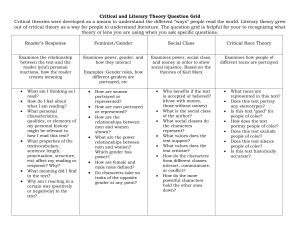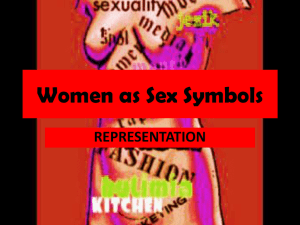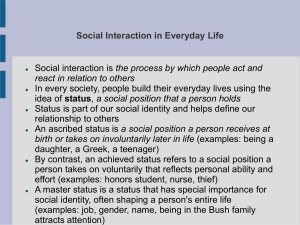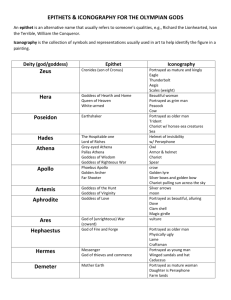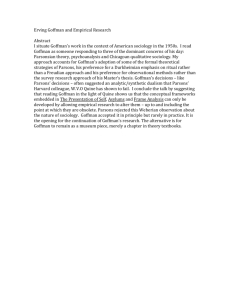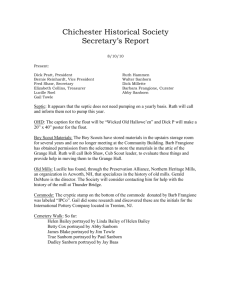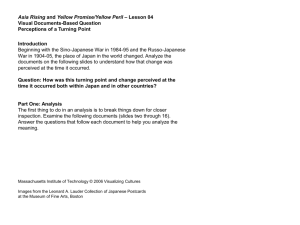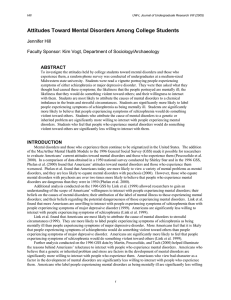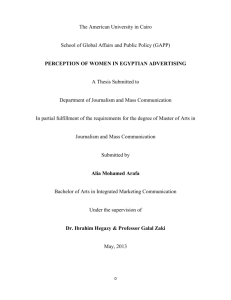Research assignment The Codes of Gender Part 1 As it applies to
advertisement
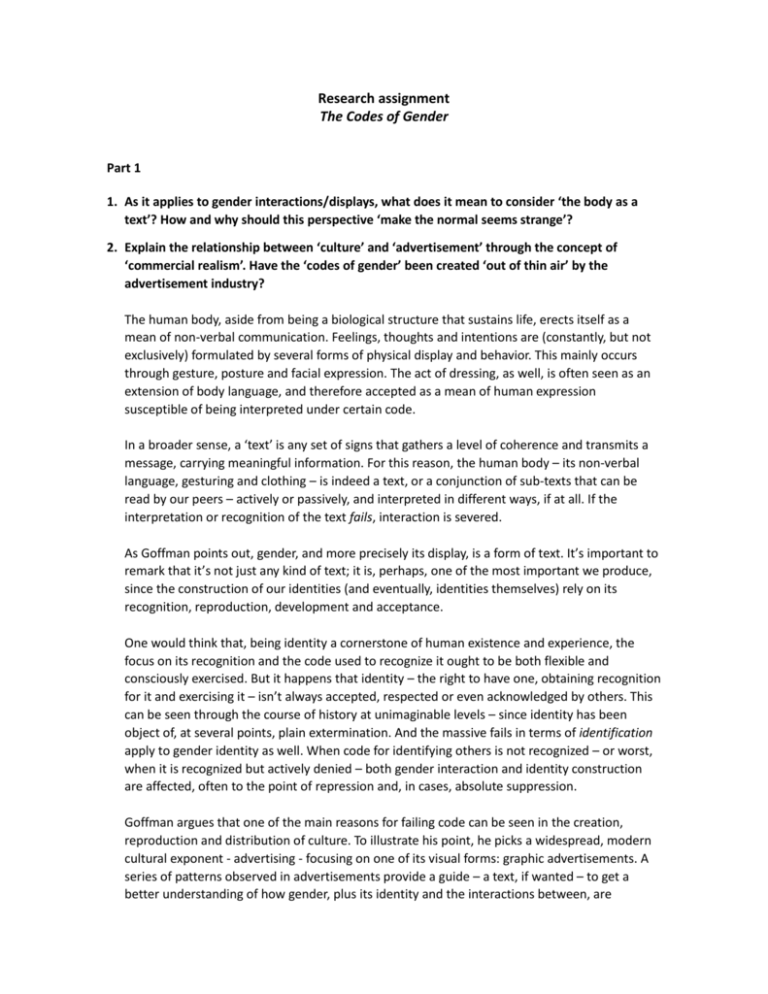
Research assignment The Codes of Gender Part 1 1. As it applies to gender interactions/displays, what does it mean to consider ‘the body as a text’? How and why should this perspective ‘make the normal seems strange’? 2. Explain the relationship between ‘culture’ and ‘advertisement’ through the concept of ‘commercial realism’. Have the ‘codes of gender’ been created ‘out of thin air’ by the advertisement industry? The human body, aside from being a biological structure that sustains life, erects itself as a mean of non-verbal communication. Feelings, thoughts and intentions are (constantly, but not exclusively) formulated by several forms of physical display and behavior. This mainly occurs through gesture, posture and facial expression. The act of dressing, as well, is often seen as an extension of body language, and therefore accepted as a mean of human expression susceptible of being interpreted under certain code. In a broader sense, a ‘text’ is any set of signs that gathers a level of coherence and transmits a message, carrying meaningful information. For this reason, the human body – its non-verbal language, gesturing and clothing – is indeed a text, or a conjunction of sub-texts that can be read by our peers – actively or passively, and interpreted in different ways, if at all. If the interpretation or recognition of the text fails, interaction is severed. As Goffman points out, gender, and more precisely its display, is a form of text. It’s important to remark that it’s not just any kind of text; it is, perhaps, one of the most important we produce, since the construction of our identities (and eventually, identities themselves) rely on its recognition, reproduction, development and acceptance. One would think that, being identity a cornerstone of human existence and experience, the focus on its recognition and the code used to recognize it ought to be both flexible and consciously exercised. But it happens that identity – the right to have one, obtaining recognition for it and exercising it – isn’t always accepted, respected or even acknowledged by others. This can be seen through the course of history at unimaginable levels – since identity has been object of, at several points, plain extermination. And the massive fails in terms of identification apply to gender identity as well. When code for identifying others is not recognized – or worst, when it is recognized but actively denied – both gender interaction and identity construction are affected, often to the point of repression and, in cases, absolute suppression. Goffman argues that one of the main reasons for failing code can be seen in the creation, reproduction and distribution of culture. To illustrate his point, he picks a widespread, modern cultural exponent - advertising - focusing on one of its visual forms: graphic advertisements. A series of patterns observed in advertisements provide a guide – a text, if wanted – to get a better understanding of how gender, plus its identity and the interactions between, are displayed, reproduced and consumed in western cultures. The patterns observed in graphic advertisement show a code that stands on limited, biased views about gender identity and role that end up configuring a particular norm – if we agree on norm as a cultural product that represent knowledge of what others do and what others think that we should do. And by ‘limited, biased’, I’m not alluding to the limitations of (any) format, but instead, to the result of what (and how) is showed through it. Here, advertisements show by fact (composition, display, reproduction, history) that the accepted gender roles are male and female, and that those roles possess a set of discernible characteristics. And by massively reproducing this code, advertising shows its own version of normality, one where a normal male identity is muscular and assertive, and a normal female identity is submissive, dreamy and defenseless. Once we recognize pattern and acknowledge representation, code can be interpreted, reinterpreted and questioned: this is where ‘normality’ – as a reliable, consistent representation of reality – becomes strange, since it frequently proves itself remarkably out of the contexts that reality offers. Goffman has coined the concept of ‘commercial realism’ to describe this phenomenon, where reality is (re)presented in a way that could be real. Question is: could the hierarchical, ancestral model of society that is shown in advertisements be real? It certainly is a realistic representation of past times, of ancestral views that prevailed over centuries in western societies, even of views that still find powerful advocates in present time. However, under the light of recent – and not so recent – events, this hierarchical views about gender and society are becoming stranger by the minute. Codes of gender – gender interaction, display, recognition, acceptance - are changing in ways that prove Goffman’s reasoning as correct. Part 2. Codes of Gender and Representation of Feminity 1. Ritualization of subordination. Women in print advertisements are portrayed in positions that communicate submission and defenselessness, such as lying down or in complex, uncomfortable body displays. When standing, lack of balance is a common display. When portrayed along men, submission appears in more crude ways: women are portrayed below men, off center, appearing dreamy or focused on men. In appendix, example n°1. 2. Infatilization Distinction between infant and adult behavior and body language is often omitted. Women are portrayed in childish manners, with the addition of sexual connotation. The line that separates children from adult women is (intentionally) blurred, while posture, gesture and dressing resemblance is exacerbated. In appendix, example n°2. 3. Licensed withdrawal Women’s facial and eye gesturing tend to express unawareness of context. They appear as drifter beings in a dream-like state, absent from their surroundings. In contrast, male gender roles are portrayed with opposite characteristics, such as concentration, awareness and sense of alert. In appendix, example n°3. Part 3. On Robin Thicke’s ‘Blurred Lines’ and the subsequent ‘Defined Lines’ video (parody/criticism video). Both Prof. Gofmann and Prof. Jhally remark that displacement and/or replacement of traditional gender roles by unexpected, unassociated gender behavior can act as an effective way of ‘raising eyebrows’ or, more specifically, questioning our expectations on gender identity, interaction and display. The parody video certainly raises awareness on how women are portrayed, depicted, treated and referred to in Thicke’s video, by inverting the roles and changing the lyrics. I’m tempted to catalogue the attempt as ‘simple’, but, on second thought, I believe that a notable effort in terms of filming, editing and production is observed in ‘Defined Lines’. I particularly believe that the criticism expressed in the second video is a valid path in the array of possibilities that can be imagined. However, I find importance in remarking that, while the video doesn’t appeal to me in an ultimately personal way, it has proven itself effective in terms of communicating a different point of view to a large audience (to the date, the video’s almost reached 5 million views in YouTube). On a more personal note, I believe that using the figure of analogy is a step forward, as long as it aims for higher grounds. If standing on the shoulders of pop culture and using a different set of tones (humor, irony) leads to broader reflections on gender issues and serious discussion about the consequences of gender portrayal, we would be in presence of a worthy effort. Appendix Figure 1 – Ritualization of subordination Gender role assigned to the woman is associated with the cleaning, a traditional house chore; the woman is depicted in a submissive posture – barefoot, on her knees. Figure 2 - Infantilization Child-like symbols (drawing in the walls) are integrated to a sexualized image of a woman (where her legs are real, while the rest of her body isn’t). The drawing of the woman is absent from its surrounding. Figure 3 – Licensed withdrawal Woman is portrayed as absent. She lies down while active, muscular men explore her body. Her eyes are suppressed, her body is naked; she’s defenseless, blind to the surrounding action.
